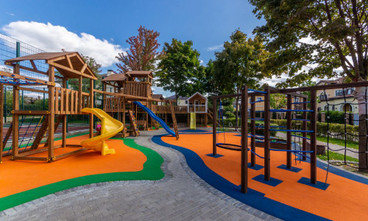Playground borders are essential and serve a dual purpose. They act as protective barriers around the playground, enhancing its visual appeal while significantly boosting safety. Discover how playground borders can help prevent accidents and the common materials used to make them.
Understanding Playground Borders
Playground borders serve as frames for the play area, enhancing its aesthetics and safety. These borders are essential as they provide a safe and secure space for children to enjoy their playtime.
Preventing Injuries With Playground Borders
Understanding how playground borders can help prevent accidents is key to building a safe space. Playground borders play a critical role in preventing accidents and injuries. Some of the ways these borders protect children include:
- Containing the surface materials
- Establishing the play space
- Reducing tripping risks
Below, we expand on each of the bullet points mentioned above.
Containing the Surface Materials
Playground borders prevent equipment from shifting or moving out of place, ensuring children have a stable and safe play environment. They also contain the grounds’ surface material, such as rubber mulch or woodchips, preventing children from tripping over it when they exit the play space.
Establishing the Space
Borders help prevent accidents by providing a visible boundary for children to play within. This way, kids learn to stay within the designated area and not wander into potentially dangerous areas.
Reducing Tripping Risks
Playground borders also serve as a barrier between the play area and surrounding surfaces, reducing the risk of children tripping or falling onto hard surfaces. The smooth edge of playground borders creates a safe transition from one surface to another, preventing injuries that may occur due to sudden elevation changes.
Common Materials Used for Playground Borders
Woodchips are a traditional option for playground borders that we still see on occasion at older playgrounds. While the material designates the play space from other spaces, it isn’t an ideal option since wood splinters. Children playing with or around the border could get painful splinters.
Plastic borders are a modern alternative to wood since they’re less likely to break down, ensuring the border remains intact over time. Plastic playground borders won’t cause injuries such as splinters if children run their hands along them while playing.
Shop at Discount Playground Supply
Playground borders are an essential safety feature for any outdoor play area. At Discount Playground Supply, we offer high-density polyethylene plastic boarders to ensure durability. Invest in high-quality materials to ensure a safe playground where children can have fun.

